Watery pimples on the body of an adult or child look like cavities raised above the skin level, filled with transparent watery exudate or yellowish ichor. In medicine, such formations are called vesicles. The rashes are most often localized on the stomach, arms, legs, fingers, and less often on the face, palms and feet. The development of the rash may be accompanied by itching.
Why does a vesicular rash appear?
Watery acne on the body occurs for various reasons. Often their formation is associated with a viral or bacterial infection. The appearance of a rash can be caused by:
- hives;
- prickly heat;
- chicken pox;
- sunburn;
- shingles;
- eczema;
- mycoses;
- herpes;
- scabies mite;
- dyshidrosis
Vesicles can appear on the body as a result of hormonal imbalance. Many women face such troubles and rashes of various types during pregnancy.
In some cases, the cause of the rash lies on the surface and you can determine its origin on your own, in others you cannot do without the help of a doctor and appropriate tests. It is necessary to visit a pediatrician/general practitioner or dermatologist.
Photo of vesicular rash
To determine the diagnosis, not only the presence of vesicles is taken into account, but also the accompanying symptoms. These include itching, fever, redness, peeling of the skin and other indicators. However, a preliminary assessment of the disease is possible based on the nature of the rash, shape and location.
Photo with explanations:
- Hives. This disease falls into the category of dermatitis, mainly of allergic origin. The skin reacts with rashes to an external irritant (mechanical damage, chemicals). Urticaria is typically characterized by the sudden formation of multiple pale pink blisters, accompanied by severe itching.
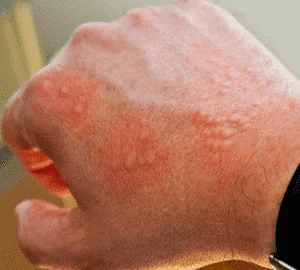
Watery pimples with urticaria
- Prickly heat - skin irritation caused by increased sweating. It is more often observed in infants and forms in skin folds, on the neck, buttocks, and back. In an adult, prickly heat can occur due to excess weight, the application of warm compresses, or an increase in temperature. The rash is localized in the armpits, folds under the breasts, inguinal-scrotal area, and on the hands. Miliaria begins with mild itchy redness of the skin, which develops into small watery blisters.
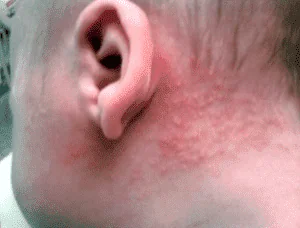
Miliaria in infants
- Chicken pox - a childhood viral disease (also occurs in adults), the initial stage of which is characterized by the appearance of red spots with a diameter of 2-4 mm. After a few hours, the spots transform into blisters surrounded by a characteristic halo. Chickenpox is accompanied by itching. Subsequently, crusts form in place of the bubbles, which disappear on their own.

Chicken pox
- Shingles - a disease that occurs in adults, especially older people. The causative agent is the same virus that causes chickenpox in young people. The specificity of herpes zoster is unilateral rashes with severe pain. The development of the disease begins with an increase in temperature and severe burning in the affected area. Then there is redness of the skin, in place of which, within a day, small watery pimples form. Vesicles can merge with each other.
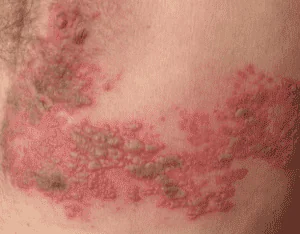
Herpes zoster in an adult
- Eczema - a type of dermatosis, the development of which is promoted by external (mechanical, chemical) and internal (pathologies of the nervous system, liver, kidneys, etc.) factors. There are several clinical varieties of the disease. A characteristic sign of some forms of eczema is redness of the skin followed by the formation of vesicles filled with serous fluid. The disease affects various parts of the body, lasts a long time and has a tendency to recur.
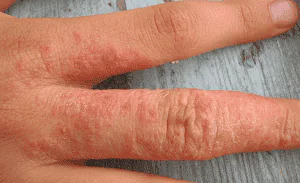
Blistering eczema
- Mycoses - fungal infections of the dermis on the legs, arms and other parts of the body. The disease begins with slight peeling, itchy blisters appear, which merge into one large lesion, diaper rash or roughness and cracks form.

Fungus on feet
- Herpes simplex - a virus with a typical grouped eruption of water bubbles. The most common form of the disease is the labial form. It is also called vesicular lichen and cold sores. Herpes can appear against a background of weakened immunity after infectious diseases, hypothermia, or severe stress.
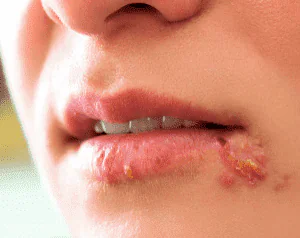
Herpes on the lips
- Scabies - a highly contagious skin disease caused by a microscopic mite - scabies. It manifests itself with symptoms such as a papular rash, which eventually turns into a vesicular rash, as well as severe itching. When scratching, staphylococcal and streptococcal infections may occur with the formation of pustules. The mite makes passages in the skin that are visible to the naked eye, and this is one of the indicative signs of scabies. Although sometimes the disease occurs without scabies.

Scabies
- Sunburn - the result of excessive tanning in adults and children. The skin becomes covered with multiple blisters with serous fluid inside. In addition to the rash, other symptoms may occur, such as dizziness, weakness and nausea.
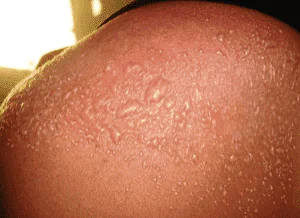
Sun burns
- Dyshidrosis. Since the skin lesions of this disease are similar to eczema, it is called dyshidrotic eczema. The factors leading to the development of dyshidrosis are not fully understood. Previously, it was believed that the disease occurs due to blockage of the ducts of the sweat glands. Now the disease is considered as an allergic companion to food or drug toxicoderma. Dyshidrosis primarily affects the skin of the feet and hands.



